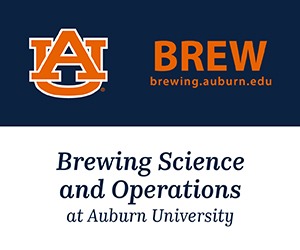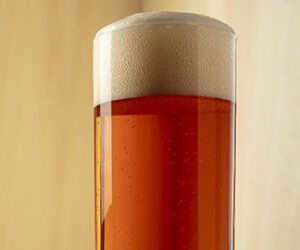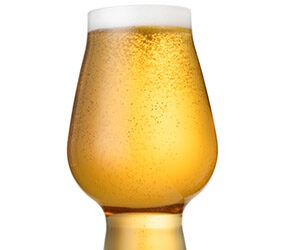Old-World Alt
From the central train station in Düsseldorf, I was making my way toward the charming Altstadt district. Düsseldorf is a bustling city on the Rhine river in western Germany, and Altstadt, which means “old city,” is the historic part of town. On its centuries-old streets you can find many of Düsseldorf’s traditional culinary treasures, such as mettwurst, Mainzer beer cheese, and the world’s greatest pretzels and hot mustard.
The pretzels alone are worth the trip, but I wasn’t in Düsseldorf to eat. I was there to learn how to brew the city’s legendary altbier.
Ales have been brewed in Germany for 3,000 years, and alt is the ale that has long defined Düsseldorf. “If you ask for a beer in Düsseldorf, you get an altbier,” writes Horst Dornbusch in “Altbier” (Brewers Publications, 1998). “If you want pils or weizen, you have to ask for it specifically.” The name, which means “old beer,” describes an ale fermented cool with top-fermenting yeast, then aged near the freezing point in the Düsseldorf style. Alt is a full-bodied beer, a bit like a British brown ale or bitter. Since it’s not exported, this style can be hard to find in the United States. Take it from me: It’s worth flying across the Atlantic to taste Düsseldorf alt from the tap.
Altstadt’s cobblestone streets are lined with cozy, old-time taverns that have plenty of Old World charm … and plenty of altbier. Walking into a Düsseldorf pub is like stepping into a time warp. Single-tap wooden barrels dispense alt into traditional straight-sided, 0.3-liter glasses, one after another. Once you’ve been served an altbier, the coaster under the glass serves as a tally for the number of beers consumed. The only way to stop your glass from being filled is to place the coaster on top of the glass, which tells the waiter you’re finished. The blue-aproned waiters carry revolving trays of altbier while collecting empty glasses on the fly. The glasses are then half filled, let to stand, and topped up to establish a dense, frothy head. The waiters will occasionally pause to enjoy an altbier at the customer’s expense, usually finishing it in one or two gulps.
In Altstadt, you will find three of the four breweries that have defined the style: Zum Uerige, Im Füchschen and Zum Schlüssel. The fourth brewery, a mile outside the historic district, is the Brauerei Ferdinand Schumacher. Founded in 1838, Schumacher is the oldest continually-operating altbier brewpub in the city. “The founder, Ferdinand Schumacher, took the traditional Rhineland ale as he found it, but added a bit more hops than was customary at the time, brewed it stronger, and started to experiment with aging the beer in casks to let it mature,” writes Dornbusch. “In these innovations lie the roots of the modern altbier style: a robust, coppery, slow-fermented and lagered ale.”
These classic breweries have a rustic atmosphere. Patrons gather around the old wooden barrels, used as tables, and drink glasses of alt while munching on aged cheeses and blood sausage. Some of the brewpubs even have their own in-house butchers, who serve the freshest meats and cheeses imaginable. Other pubs serve hearty full-course meals of wild boar, duck and eisbein (boiled knuckle of pork).
Making Alt the Düsseldorf Way
During the two days I spent in Düsseldorf, I took extensive tours of the Füchschen and Uerige breweries. The brewers were happy to share their alt techniques with a colleague from the United States, though they were guarded about their proprietary yeast strains. I followed along as they described their alt in German; in both pubs, an accommodating waiter helped me translate. The head brewer at Füchschen even gave me his recipe. (I have that beer on tap at my brewpub.)
Replicating a quality altbier is a challenge. The original gravity should range from 1.045 to 1.052. Alts are copper to brownish-amber in color and medium- to full-bodied, with a firm malt character that is not overwhelming. Altbier has a medium to high bitterness level, with a minimal hop aroma. The hop character must balance the overall impression of the beer. It has a crisp, dry finish, complemented by a nutty malt character without roasty overtones.
Altbiers are fermented cool, using a top-fermenting ale yeast, in open fermentation squares. Then they are lagered for an extended period of time, usually four to six weeks. Cold secondary conditioning is required for the clean, dry taste that typifies the style. Due to the low fermentation temperatures, you’ll want a high pitching rate (double the size of your yeast starter). Aerate your wort aggressively.
Brewing water, medium hard
The brewing water should have a medium hardness. If you add salts, use calcium chloride rather than calcium sulfate. This will enhance the beer’s fullness and maltiness and produce a mellower mouthfeel. Some Düsseldorf pubs use untreated tap water and lower the pH of the mash by adding acid malt at 1 to 2 percent. Always remember to de-chlorinate your water.
Malt for your authentic alt
Good altbier starts with good German malts. Altbiers have higher hopping rates that require a firm malt presence throughout. The base malt is German pilsner, while the addition of Munich malt at 5 to 20 percent will lend a mild sweetness and add some color. Most Düsseldorfer alts include a small percentage of CaraMunich (5 percent) and black or chocolate malt (1 to 2 percent). I use a bit of de-husked, de-bittered chocolate malt, such as Carafa III, at 1 to 2 percent. This will lend a deep, tawny copper color to your alt. Some pubs also use a little German dextrin malt (CaraHell) to add body and head retention. American brewers tend to add too much caramel malt and not enough hops.
Fresh German hops
Fresh hops are critical for producing a classic Düsseldorfer altbier, which ranges in bitterness from 35 to 55 IBU. Most Düsseldorfer pubs use Spalt hops for bitterness. My favorite brewery, Im Füchschen, uses Hallertau Tradition for bitterness. Other suitable hop varieties would include German Tettnang and Czech Saaz. American varieties also work well. I suggest Liberty, Mount Hood, Ultra and Crystal. Pound for pound, pub alts are bitter beers, so focus on getting two-thirds of the bitterness at the beginning of the boil. The average boil is 80 minutes, and most breweries use three additions in the kettle: the first at 80 minutes, the second at 60, and the third 5 minutes before the end of the boil. Use a light hand during the last two additions. For added complexity, try dry hopping your alt in the secondary.
Yeast and fermentation
Arguably, alt yeast is the most important ingredient in reproducing the classic altbier style. Altbier should only be made with alt yeast. This “alt” to be a rule!
Alt yeast has a unique ability to ferment at cooler-than-normal ale temperatures. These cooler temperatures produce a cleaner, less fruity and more delicate flavor profile. The cooler fermentation temperatures reduce fruity esters and produce lager-like results. Fermentation should be conducted between 60° and 64° F for 3 to 6 days. Alt yeasts are low-flocculating strains. This increases its ability to hang in suspension. As a result, the yeast removes compounds and refines beer flavors. Altbiers produce a dense, rocky head of krauesen, so allow plenty of headspace in your fermenter. My favorite strain is Wyeast 1007 (German Ale), which is similar to the Düsseldorfer pub yeast in its dry, crisp character.
After primary fermentation, condition the beer for three to six weeks at near-freezing temperatures. This will help clear the alt, refine the flavors and soften the overall character of the beer. Excessive fruity esters, caused by abnormally warm ale fermentations, can be reduced by lagering at very cool temperatures for extended periods of time. These beers require patience.
Sticke Alt is a more intense version of altbier. These “secret beers” are brewed stronger, are slightly darker, and are dry-hopped in the conditioning tank for four to six weeks. The result is a bittersweet, ultra-crisp ale with a fresh, flowery aroma. These traditional brews are available once or twice a year, usually in September and January. I was fortunate enough to taste Sticke Alt straight out of the aging tank at the Uerige brewery. It was possibly the best beer I have ever tasted.
Below are two homebrew recipes I created after my trip. Have fun making your own alt, and here’s a toast to the legendary beer of Düsseldorf!
Sly Fox Altbier
(5 gallons, all grain)
OG= 1.052 FG= 1.010 to 1.012
IBU= 30 to 40 SRM= 15 to 18
Ingredients
- 6 lbs. German pilsner malt
- 2 lbs. German Munich or Vienna malt
- 1.25 lbs. Weyermann CaraMunich III or crystal malt (60° Lovibond)
- 1 to 3 oz. Weyermann Carafa III or black patent malt
- 6.4 AAU German Spalt hops (1.25 oz. of 5.5% alpha acid) for 80 minutes
- 1.5 AAU Saaz or Liberty hops (0.5 oz. of 3.1% alpha acid) for 20 minutes
- 3.1 AAU Saaz or Liberty hops (1 oz. of 3.1% alpha acid) for 5 minutes
- Starter of alt yeast (Wyeast 1007 or White Labs WLP036)
- 3/4 cup corn sugar to prime
Mash grains in one quart of water per pound of malt at 100° F for 15 minutes. Raise to 122° F for 20 minutes, then do a conversion rest at 150° F for 60 minutes. Mash out at 170° F. Sparge with 170° water. Boil time is 80 minutes. Alternatively, a single-step infusion mash can be used at 152° F for 60 minutes. Ferment at 60° to 64° F for six days. Rack to secondary for three weeks at 32° to 40° F. Force- carbonate or prime with 3/4 cup of corn sugar and bottle. Wait two weeks. Extract brewers can substitute 4.25 pounds light DME for the pilsner malt.
Sticke Alt
(5 gallons, extract with grains)
OG=1.052 to 1.055 FG= 1.010 to 1.014 IBU= 30-40 SRM= 14 to 16
Ingredients
- 3 lbs. pilsner dry malt extract
- 2.5 lbs. German Munich malt
- 2 lbs. Weyermann CaraMunich III or crystal malt (60° Lovibond)
- 0.75 lb. German CaraHell or CaraPils
- 3 to 4 oz. Weyermann Carafa III or black patent malt
- 6.4 AAU German Spalt hops (1.25 oz. of 5.5% alpha acid) for 80 minutes
- 1.5 AAU Saaz or Liberty hops (0.5 oz. of 3.1% alpha acid) for 20 minutes
- 3.1 AAU Saaz or Liberty hops (1 oz. of 3.1% alpha acid) for 5 minutes
- 1 tsp. Irish Moss at 20 minutes
- Starter of alt yeast (Wyeast 1007 or White Labs WLP036)
- 3/4 corn sugar to prime
Bring 1.25 gallons of water to 155° F. Add grain and hold for 30 minutes at 150° F. Strain grain into the brewpot and sparge with 1/2 gallon of 168° F water. Add the extract and bittering hops. Bring the total volume in the brew pot to 2.75 gallons. Boil for 60 min. Add the flavor hops and Irish moss. Boil for 15 min., then add the aroma hops. Boil 5 min, then remove from stove. Cool wort. Strain into fermenter and add chilled, preboiled water to obtain 5.5 gallons. Add yeast when wort has cooled to 70° F. Aerate well. Ferment at 60° to 64° for 7 days. Rack into secondary (glass carboy). Condition at 32° to 40° F for approximately 5 weeks. Force carbonate or prime with corn sugar and bottle. All-grain brewers can swap 4.5 pounds of pilsner malt for the DME.



